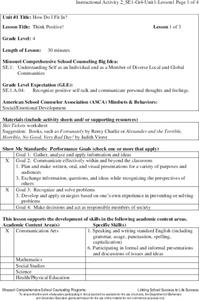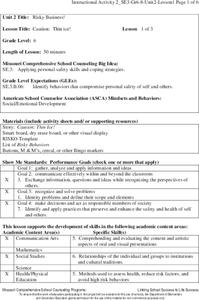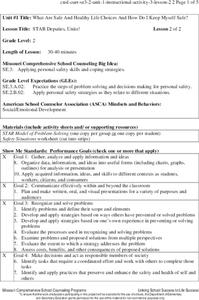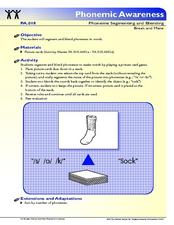Missouri Department of Elementary
Think Positive!
Following an attention-grabbing read-aloud, scholars brainstorm ways they can change negative thoughts into positive thoughts. Small groups plan and perform a skit that showcases one of the new ideas to uplift one's feelings....
PBS
Stories of Painkiller Addiction: Prescription Drug Abuse Awareness Campaign
The I-STOP law was designed to regulate the distribution and tracking of prescription drugs. After reading an article about its signing and implementation, middle and high schoolers work together to come up with their own ideas for an...
Missouri Department of Elementary
Goldilocks Revisited
After a read-aloud of the story Goldielocks and the Three Bears, scholars gather into small groups to answer a series of questions. Peers examine the idea of smart decisions and identify three feelings of characters alongside three...
Missouri Department of Elementary
Caution: Thin Ice!
Sixth graders listen to a story titled "Thin Ice!" then partake in a whole-class discussion asking and answering questions about what was read. Scholars brainstorm risky behaviors in preparation for a game of RISKO—a game similar to...
Missouri Department of Elementary
STAR Deputies, Unite!
STAR deputies unite! Scholars gather in small groups to solve problems using the STAR method. Pupils read a card that describes a situation that requires problem-solving. They role-play the scenario in front of their peers.
Curated OER
Narratives
Add to the narrative writing experience. Elementary or middle school writers listen to the teacher read a descriptive passage, then reread the same passage silently. They highlight sensory details and figurative language, then orally...
Curated OER
Help Wanted
In this factual text worksheet, 6th graders read through several want ads and then answer the detailed questions that follow to check their reading comprehension skills.
Curated OER
Radical Reconstruction
Students explore the Republican plan for Radical Reconstruction. In this reading comprehension lesson, students use a PowerPoint presentation given by the teacher and multiple texts to answer questions that help them understand why the...
Curated OER
If I Could Fly
Students listen to an oral reading of the book Tar Beach, start and exit the Kid Pix program, use the mouse and the keyboard as input devices, and use the software to create a painting to express their ideas generated by the reading of...
Curated OER
‘Pay it Forward’ Lesson Plan
Students develop their speaking skills. In this oral communication lesson plan, students read "One Hen" by Katie Smith Milway and work in groups to discover how making a small loan to the main character in the story had positive effects....
Curated OER
The 80 Question Oral Quiz- Test Your Listening Skills!
In this dictation quiz instructional activity, students listen and write as the teacher reads the numbers, letters, and words given in the list. They can read the words to each other as an adaptation of this instructional activity. The...
Reed Novel Studies
Superfudge: Novel Study
Has everyone heard the news about the herd of antelope? Scholars explore homonyms with the novel study for Superfudge by beloved children's author Judy Blume. Additionally, they answer text questions and engage in language activities....
Joel Michel Studies
The Tale of Despereaux: Novel Study
What kind of mouse is Despereaux Tilling ... a field mouse? A white-footed mouse? With the novel study for The Tale of Despereaux by Kate DiCamillo, scholars research the different species of mice and draw pictures of the one that they...
EngageNY
Building Background Knowledge: Why Do Workers Strike? (Chapter 11: "Los Aguacates/Avocados")
Make connections between Esperanza Rising and human rights with the activities outlined here. The instructional activity starts out with a brief quiz and review of the novel. After that, pupils circulate and share quote strips that you...
Florida Center for Reading Research
Phonemic Awareness: Phoneme Segmenting and Blending, Break and Make
Young learners build phonemic awareness and strong phoneme blending skills. Pairs guess the image on the card based on the word segment sounds given by blending what they hear.
Novelinks
So Far from the Bamboo Grove: Visual Vocabulary and List-Group-Label
To make vocabulary words drawn from So Far from the Bamboo Grove memorable, class members select a word from the provided list and incorporate this word in a joke, story, or performance.
Curated OER
The 80 question oral quiz
In this oral quiz worksheet, students write what they hear the teacher say, which includes numbers, letters, and words. Students write 80 items.
Curated OER
Putting Reading first: Keys to Comprehension
Second graders recognize what comprehension is and can explain the strategies they are using. In this reading comprehension lesson plan, 2nd graders self assess the strategies they are using to comprehend a text. Students answer...
Curated OER
Listen to This
Seventh graders listen to a set of instructions and complete a drawing. For this listening skills lesson, 7th graders listen to a set of oral directions and follow a command. Students then listen to a second set of directions to draw a...
Curated OER
Learning to Summarize a Story
Students with hearing loss read independently and understand what is being read to them. In this independent reading lesson plan, students sequence and discuss the book that is read.
Curated OER
Eloquent Speech
Second graders discover that oral and written communication can be improved, and made to sound more eloquent, when the following questions are addressed; Who? What? Where? When? Why? students use word processing to copy a poem using clip...
Curated OER
Not Just Words
Young scholars work to improve their oral expression while reading aloud. They read and record an entire story with a partner and listen to the playback of the readings. They evaluate their expressive language using a given checklist.
Curated OER
Geo Jammin' - Day 2, Lesson 6: Rhyme and Reason
Students listen to the poem "Shapes" by Shel Silverstein in order to accurately and specifically describe shapes' rules/traits in their journals. They illustrate the poem and take turns reading during a creative shared reading session.
























